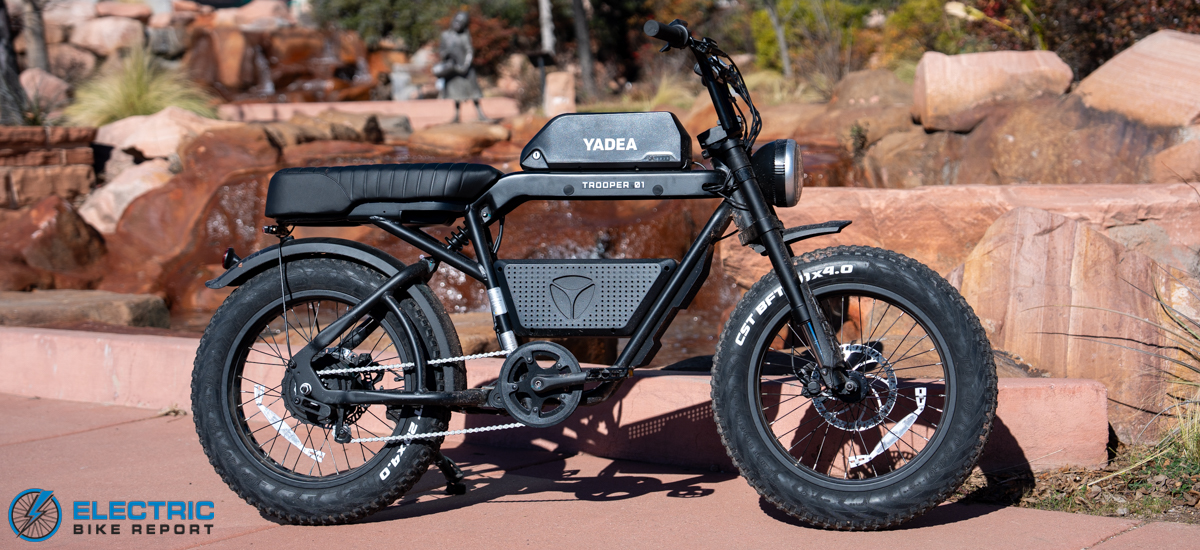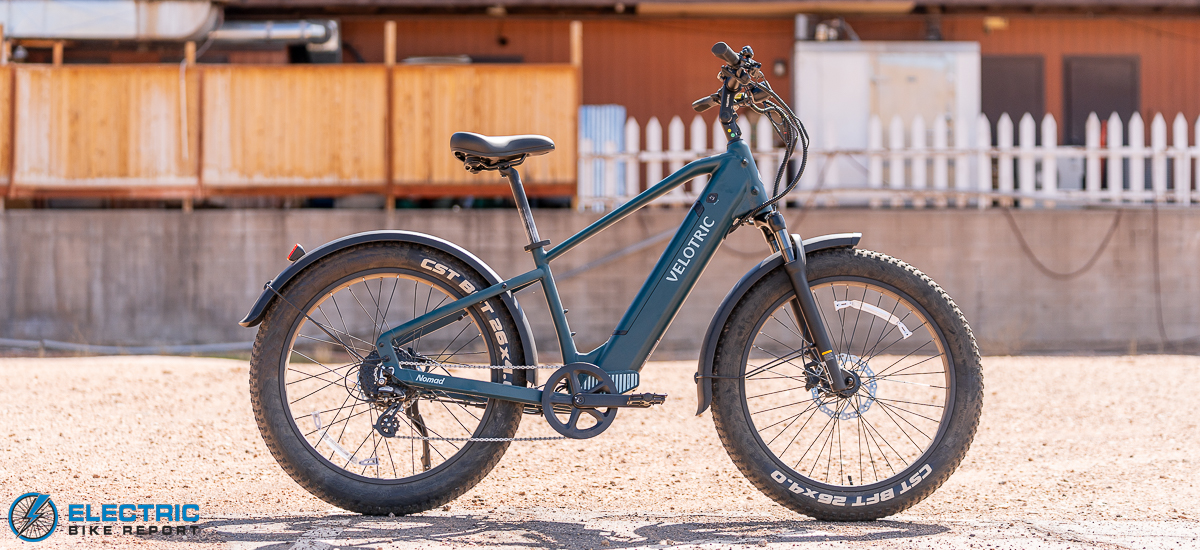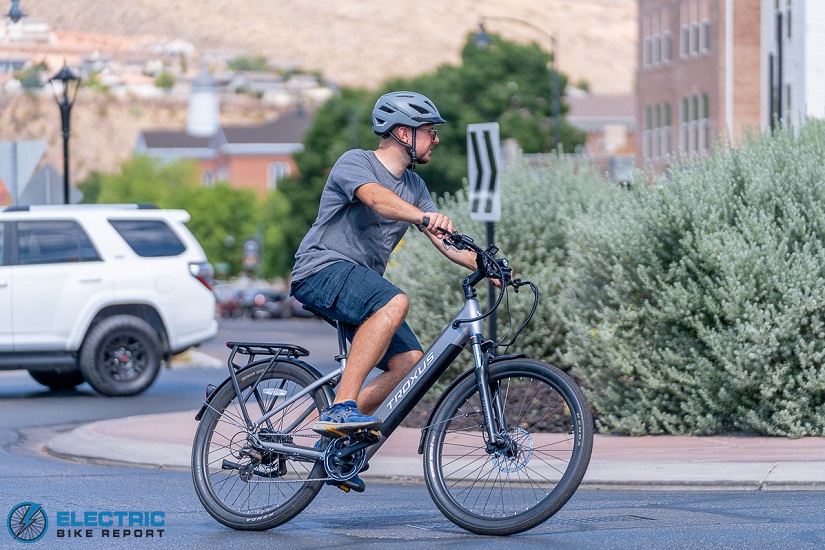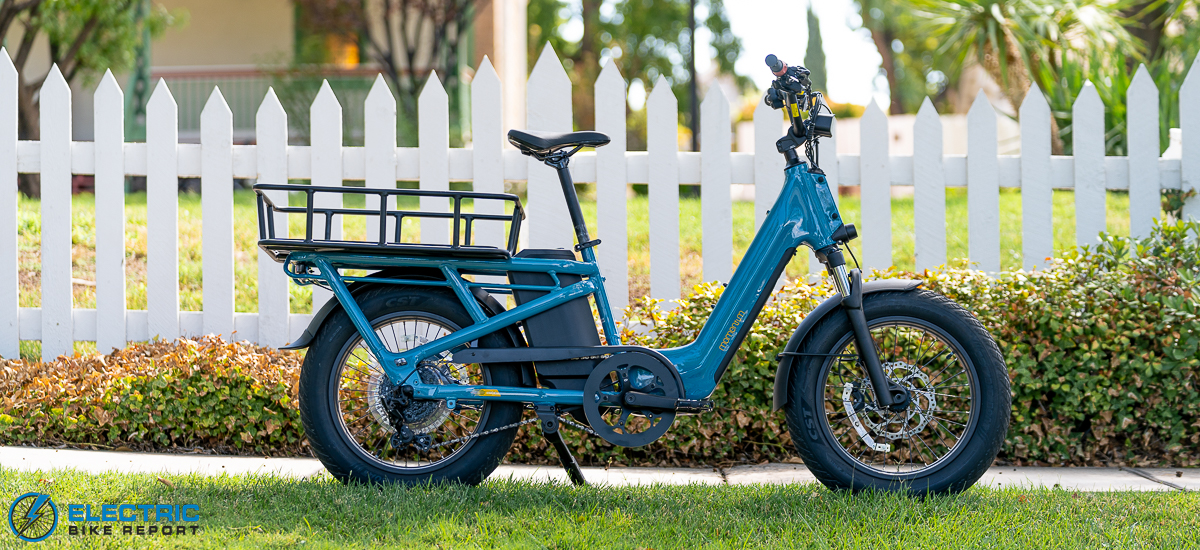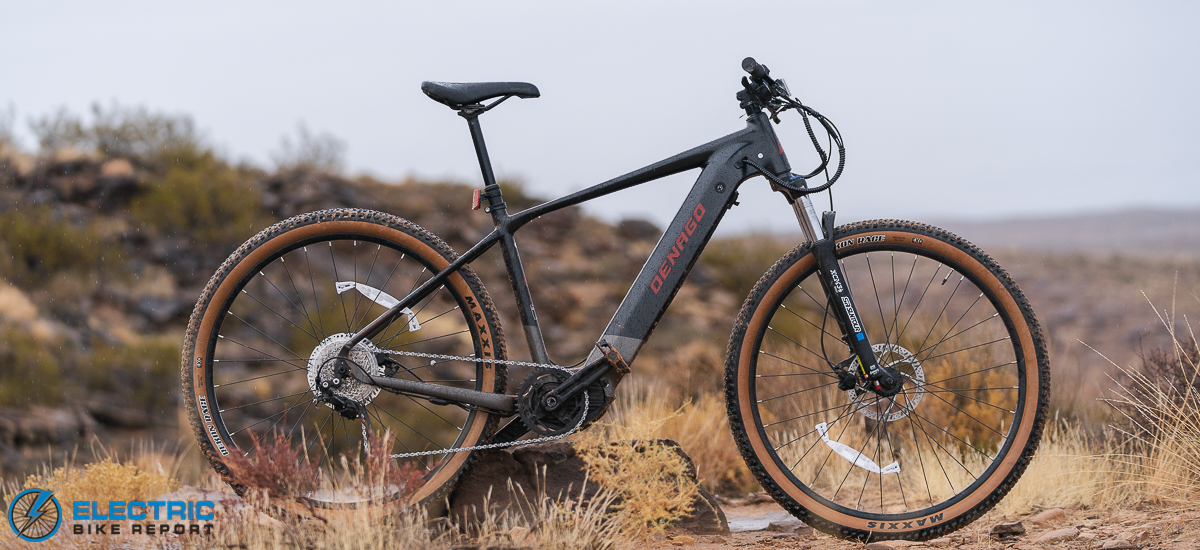
Some links may be affiliate links. We may get paid if you buy something or take an action after clicking one of these.
A value-packed entry-to-mid-level eMTB with a powerful and responsive motor.


The eXC2’s Bafang M510 mid-drive motor is one of its prominent features; it has 250 watts of nominal power and an eyebrow-raising 95 Nm of torque. This amount of output provided an easy yet thrilling ride, and helped the bike to conquer steep hills without breaking a sweat.
A more powerful motor is just one of the upgrades that justify the eXC2’s price between $3,000 and $3,500. With a larger 720 Wh battery, a wider gearing range, a color display, a sturdier suspension fork, and more – we think the bike provides solid value with a clear spec difference when compared to the base model.
This top-tier version of the bike might have a number of upgrades, but it shares a solid foundation with the eXC1. With modern geometry for comfort, cornering, and control, the design of the eXC2’s frame gives it a great feel for practical use on smoother singletrack.
We put the bike through its paces in tough desert terrain as well as in our series of standardized Speed, Range, Hill, and Brake Tests. The following Denago eXC2 review will reveal our thoughts on its results!
Bike Category:eMTB
Class 1 E-Bike:Pedal assist up to 20 mph
Denago eXC2 Video Review

 Pros
Pros- We liked the powerful feel and climbing ability of Bafang’s most robust 250W M510 mid-drive.
- Stands as a complete upgrade over the eXC1 for its price between $3k and $3,500 with its more powerful motor, higher-capacity battery, dropper post, sturdier suspension, and more!
- Great geometry for practical trail use (shared with Denago’s eXC1).
- Comes in three frame sizes for a more precise fit, which isn’t always possible at entry-level prices.
- Responsive handling with controlled steering thanks to the 29×2.4” Maxxis Rekon Race tires and 740mm/780mm handlebars.
- Includes a colorful, easy to read display with tons of ride data.
- Fully equipped with good entry-to-mid-level components that can be upgraded if/when needed.

 Cons
Cons- The eXC2’s motor output pauses briefly when shifting. It picks up faster than the eXC1, but we’d still like to be able to deactivate this feature.
ELECTRICAL SPECS & FEATURES
- Battery: Bafang 720 Wh (48V, 15.0A), IPX6 Water-Resistant rated
- Display: Bafang DP C244.CAN
- Motor: Bafang M510 Mid-drive, 48V, 250W; 95Nm torque, IP65 Water-Resistant rated
- Headlight:None
- Taillights:None
- Pedal Assist: PAS 1-5, torque and cadence sensors
- Range: 92 miles
- Throttle: None
- UL Certification:UL 2849 Certified
Weight & Dimensions
- Claimed weight: 55 lbs (57 lbs actual)
- Rider height range: 5’-5” to 5’-9” (M), 5’-10” to 6’-1” (L), 6’-1” to 6’-5” (XL)
- Maximum rider weight: 300 lbs
Components & Accessories
- Brakes:Tektro HD-E350 hydraulic disc, 180mm rotors
- Fenders:None
- Fork:SR Suntour XCM34 LOR Boost, 100mm travel
- Frame: 6061-T6 Aluminum Alloy
- Drivetrain: 9-speed Shimano Alivio, 40T chainring, 11-34T cassette
- Grips: Black rubber, lock-on style
- Saddle: Denago custom saddle
- Seatpost: Limotec D1 150mm dropper, 10mm offset, 31.6mm diameter, handlebar remote
- Handlebar: 740mm long (size M) / 780mm long (size L/XL)
- Kickstand: None
- Pedals: Black alloy, 9/16″
- Tires: Maxxis Rekon Race, 29×2.4″, EXO casing, skinwall


The Suntour XCM34 suspension fork felt robust enough for moderately difficult terrain.


A 720 Wh battery is concealed and protected in the down tube.


The Bafang M510 mid-drive is a beast of a motor, with 95 Nm of torque.
Denago eXC2 Review: Speed Test
To evaluate the programming and motor performance of the eXC2, we rode the bike in each pedal assist system (PAS) setting and recorded our maximum speeds.
With its mid-drive motor, the bike uses a torque sensor to inform its power output; the motor dispenses more power when the rider pedals harder, and less when they pedal softer. As much as possible, we maintained a consistent, moderate level of effort to remove this variability from the equation.
To establish a baseline for the test, we also pedaled the bike with no motor assistance; our maximum speed to start was 12.8 mph. We felt a significant difference from the substantial power output of the bike’s lowest-assist setting, PAS 1, where we measured 16.7 mph. The increases in speed were consistent and incremental as we moved through the higher settings; we reached 17.9 mph in PAS 2, 19.0 mph in PAS 3, 19.6 mph in PAS 4, and 20.5 mph in PAS 5.
The graphic above shows a representation of the eXC2’s power output based on our data from this test; the bike’s Bafang M510 mid-drive clearly made use of its 48V power source and 95 Nm of torque! With its ability to draw power quickly from the battery and put out a significant amount of rotational force, we observed a huge magnification of our effort in pedaling.
The linear increase in power and speed beginning in PAS 1 is generally what we like to see from our results, though the leap from PAS 0 (where we were already moving relatively fast) to PAS 1 seems unusually large. While we like that the motor’s power output is intuitively distributed between settings once the PAS is activated, we’d prefer to see the starting power reduced for a more even spread including PAS 0.
As it is, however, we feel the eXC2 is completely functional – and also a serious blast when riding on trails. We found the power level of PAS 1 and 2 to be adequate for rocky, technical sections, with higher settings more appropriate for smoother, flowy sections or climbing.
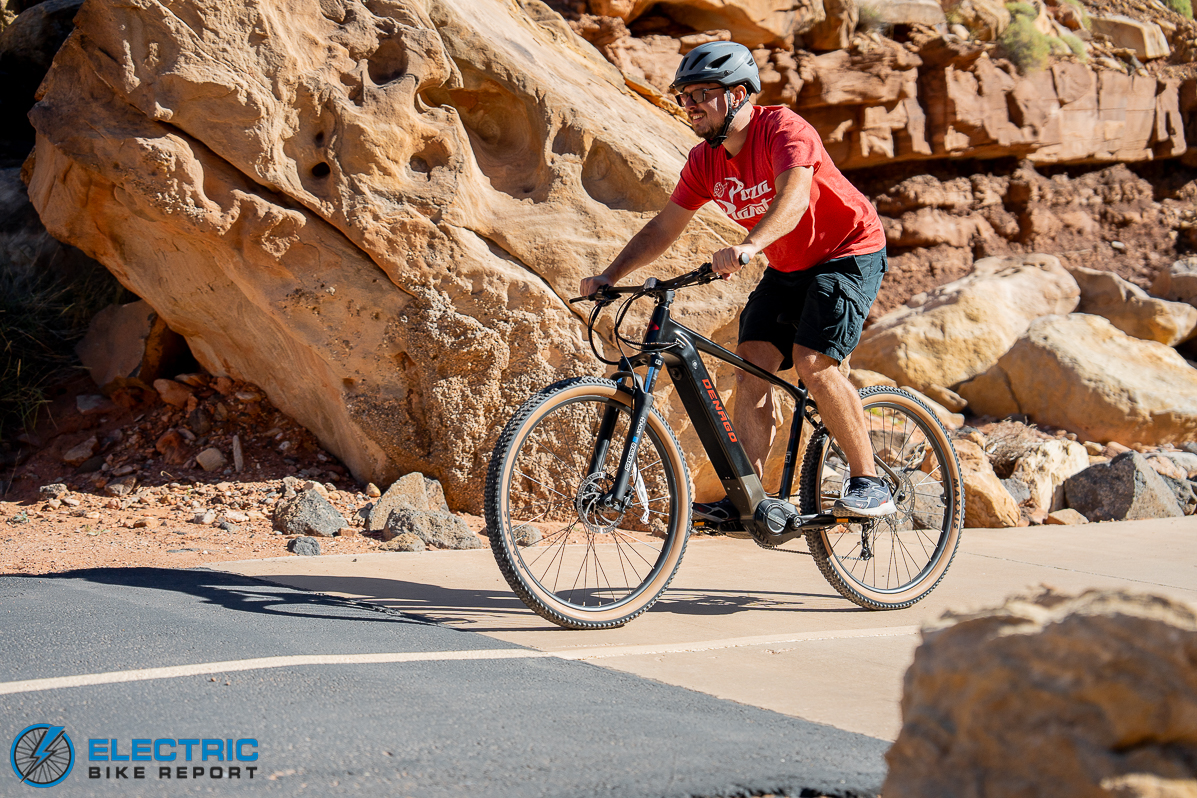

While the eXC2 is made for trails, it’s totally a bike you could ride comfortably to work or school.


The eXC2 has a slightly wider gearing range than its sibling, with an 11-34T cassette.


The Maxxis Rekon Race tires have great grip and traction for trails or pavement.
Denago eXC2 Review: Range Test
We tested the life of the eXC2’s 720 watt-hour (Wh) battery in two separate tests using its highest- and lowest-assist settings to determine realistic figures for the bike’s range. Using the motor’s maximum output, we recorded a distance of 44.5 miles over 2 hours and 55 minutes. In PAS 1, we traveled 64.5 miles in 4 hours and 38 minutes.
It’s worth noting that we performed this test on paved multi-use paths where the motor does not need to work as hard; riders should expect different results when hitting trails or any other off-road environments. We recommend performing your own range test in your local terrain to determine more realistic figures.
Our data is still useful for comparison purposes, however, as we test nearly all e-bikes on our paved paths. When compared to similar eMTBs we tested previously, the eXC2’s PAS 5 result was one of the best high-power distances we have seen. This was due to its high battery capacity; other eMTBs with 250W motors were equipped with smaller batteries that expired in less time. Other bikes with 720 Wh batteries used 500W motors and burned through power faster.
Its results in PAS 1 were a bit low, though based on our Speed Test results where the M510 motor showed a substantial output of power in that setting, this makes sense. By giving an unusually high amount of pedal assistance in its lowest setting, it was also draining the battery faster.
The 1,700+ ft of elevation we gained during our low-PAS test certainly depleted the bike’s battery faster, but regardless, our test results suggest that Denago’s advertised range of 92 miles might be fairly ambitious.
Despite this, we are satisfied with the eXC2’s results; this is a bike that may be best for those comfortable with trading some distance for an easier ride. We think it’s likely to offer enough battery life for a solid few hours of fun on the trails, and if used on the streets for commuting or casual rides, there is a chance of going for a few days before recharging is necessary.
Denago eXC2 Review: Hill Test
Not only was the bike successful, it has one of the fastest results we have measured from an eMTB. Our test rider, Justin, pedaled to the top in 1 minute and 29 seconds, maintaining an average speed of 12.2 miles per hour.
This establishes consistency with our previous tests, which showed that the eXC2 is truly a powerhouse despite having only a 250W (nominal) motor. With 95 Nm of torque, the Bafang M510 mid-drive possesses enough raw power to power up nearly any hill. By its very nature, the bike requires some effort from its rider, but the experience is made as easy as possible with such a great deal of power.
The eXC1 also performed well in this test, though the eXC2 had two advantages over its sibling: increased torque and a wider gearing range for climbing.
Our test results lined up well with experiences on singletrack and doubletrack. With the combination of the bike’s motor and grippy Maxxis Rekon Race tires, we were able to climb confidently up steep hills made of loose rock and dirt just as easily as we powered over rocky hardpack.
We also tested the eXC2 and a number of similar eMTBs at another secondary location near the Electric Bike Report office. The results in that test reinforced our “official” data as well; the bike gave one of the best performances we have experienced from among the category.
Bottom line: the eXC2 can easily and comfortably help riders to climb nearly anything


With well-designed geometry, wide handlebars, and 29” tires, the eXC2 felt stable and planted on singletrack trails.


The included Tektro hydraulic brakes provided good modulation with plenty of stopping power.


The HD-E350 brake system uses two-piston calipers and 180mm rotors on both wheels.
Denago eXC2 Review: Brake Test


The eXC2 also performed well in our Brake Test. Using the process described above, we tested its Tektro E350 hydraulic brake system, which uses 180mm rotors. After three tests, we calculated its average stopping distance to be 21’-2”.
We were pleased to note that this result is shorter/faster than average (currently 22’-11”) when compared to similar eMTBs we have tested. It’s also markedly better than what we measured from the eXC1: a 25’-3” average stopping distance.
While part of the eXC2’s improved performance is likely due to the grip of its 29”x2.4” Maxxis Rekon Race tires, it’s worth noting also that we have observed a significant degree of variability in the performance of the Tektro E350 brake system, which we estimate is standard on roughly two-thirds or more of the e-bikes we test. In this case, we were highly satisfied with its stopping power.
The Tektro hydraulic disc brakes performed well in practical use as well, allowing us to responsively modulate speed throughout our testing both on- and off-road. On singletrack trails, they were able to slow the bike quickly when we encountered tricky technical spots, and we found that feathering was effective when rolling downhill.
Avid riders may want to consider upgrading to a 4-piston hydraulic system for improved longevity when the stock brakes wear out, but the E350 system performed well. Ultimately, we feel comfortable saying that the eXC2 is equipped with a solid set of brakes that can safely and effectively bring the bike to a stop when needed.


The wide 780mm handlebars on the L/XL frames provide precise steering control and stability.


The full-color Bafang display is nice to look at and includes all necessary ride data.


We greatly appreciated the included dropper seatpost with 150mm of travel.


The Suntour XCM34 Boost suspension has 100mm of travel.
Denago eXC2 Review: Ride Quality
The eXC2 is available in three frame sizes: the Medium frame fits those between 5’5” and 5’-9”, while the Large accommodates riders from 5’-10” to 6’-1” and the XL offers a range from 6’-1” to 6’-5”. All three frame sizes have a 67.5-degree head tube angle, while their seat tube angles vary between 73 degrees and 74.1 degrees. Their effective top tube length ranges from 24.2” to 26.25”, with reach between 17.5” and 19”.
There is a difference in handlebar width between frame sizes as well; the Medium comes with 740mm flat bars, while those on the L and XL frames are 780mm wide. In addition to being comfortable, we found that the larger bars on our test bike provided excellent, precise steering control.
The eXC2’s contact points provided a good baseline in terms of comfort. The bike includes highly textured standard-style rubber grips and a custom performance-style saddle. These items largely come down to personal preference; we liked the grippy feel of the rubber grips and the generally comfortable padding of the saddle, but other riders may prefer different levels of support or squish.
In terms of the ride itself, we think the bike handled well. Its 57 lb frame was noticeable, but not clunky; the bike could carve corners effectively due to its Rekon Race tires, wide handlebars, and powerful motor. The bike’s SR Suntour XCM34 Boost coil suspension fork provides 100mm of travel to absorb bumps and uneven terrain, and while we experienced some chatter from the Alivio drivetrain components, the suspension’s added robustness gave the bike a more solid and stable feel when compared to Denago’s eXC1.


Highly textured grips help to keep your hands within quick reach of the controls.


We found the custom saddle to be surprisingly comfortable.


The bike’s coil suspension includes a lockout.


The eXC2 is only available with a black, red, and grey paint job.
This brief pause is our only real critique about the eXC2; while it is generally inoffensive and something we’d likely have adjusted to after more time on the bike, we would like to have the ability to disable it. Denago designed the motor to have this pause to protect the drivetrain from damage from shifting under load – and to help establish good shifting habits – so we’d like the ability to remove the pause once those habits are in place.
We appreciated many of the eXC2’s upgrades – aside from its motor and battery, perhaps most notably were its dropper seatpost and unobtrusive color display. We prefer dropper posts on all eMTBs, as they allow for more comfortable (and ultimately safer) descents. The sometimes difficult-to-read LED indicator panel on the eXC1 was replaced by a small but highly visible Bafang LCD.
The eXC2 functioned and felt in nearly every way like an upgrade over its sibling, but it is still worth clarifying that many of its components are still in the entry-to-mid-level range – with the highest-quality element being the motor. We think this is a positive as it allows for an affordable entry point into the sport; prospective riders can make a single purchase and hit their local singletrack comfortably.
The eXC2 is still somewhat limited by its components, however, in that it is likely to be best on smoother singletrack where technical features like rock gardens are a rarity. The bike can handle more difficult sections of trail, but without upgrades to higher quality components, riders should expect a lesser degree of comfort and performance.
As a foundation, we think the bike provides an excellent starting point with great overall ride quality.
Denago eXC2 Review: Summary / Where to Buy
Nearly all of the e-bikes we have tested from Denago have demonstrated impressive climbing ability, and with its M510 mid-drive, the eXC2 was no different. The bike performed well from start to finish, with results ranging from good to spectacular in our testing. For the most part, we found ourselves scratching our heads when attempting to identify points of critique.
If we’re being picky, we’d like the ability to disable the pause in motor output when shifting. Even then, however, the pause was slight enough that it was relatively easy to miss when shifting anywhere but when going uphill.
Otherwise, it turns out that we’re huge fans of the eXC2 and its great overall feel. With a demonstrably responsive and powerful motor, precise steering, great traction, solid level of comfort, and functional geometry – this bike is a great purchase for its price.
We’re happy to recommend the eXC2 to anyone looking for a bike that can get to work and back during the week and hit the trails on the weekends – or to those seeking a fantastic dedicated trail bike that can be added to and upgraded over time. No matter your reason for seeking a solid entry-level eMTB, we don’t think you’ll be disappointed!
Happy Riding! Make sure to let us know if you have any questions or if you think we left anything out in this review of the Denago eXC2 down in our comments section.
Reader Interactions
![]()
![]()


